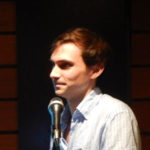V. Sabatier, J-D. Werthel, M. Vigan, A. Hardy (Paris, Boulogne-Billancourt)
Introduction : La technique de Latarjet est de pratique courante dans les instabilités antérieures de l’épaule chez les patients à risque de récidive. Les complications liées au matériel restent fréquentes après Latarjet. Avec le développement des techniques arthroscopiques, l’utilisation d’endoboutons a été proposée.
L’objectif de cette étude était de comparer les résultats cliniques des Latarjets fixés par deux endoboutons à ceux fixés par deux vis.
Notre hypothèse était que les deux systèmes de fixation obtenaient des résultats cliniques similaires, avec un taux de ré-intervention plus faible avec les endoboutons.
Méthodes : Nous avons réalisé une étude rétrospective et comparative de tous les patients opérés par Latarjet entre 2013 et 2015. Les patients majeurs à la date opératoire et avec un minimum de deux ans de suivi ont été inclus. Nous avons recueilli : les données démographiques, le nombre d’épisode de luxation préopératoire, le côté dominant, l’hyperlaxité de l’épaule, le niveau de pratique sportive, le type de sport pratiqué et le score ISIS. 431 patients remplissaient les critères d’inclusion, 308 (73.3%[IC95%=68.4% ;78.3%]) ont été inclus. Deux techniques étaient utilisées en fonction du choix et des habitudes des chirurgiens :
• une technique avec une fixation par 2 vis (soit à ciel ouvert, 4mm, soit sous arthroscopie, 3.5mm).
• une technique arthroscopique utilisant deux endoboutons (Tightrope(Arthrex)) avec une réparation de Bankart associée.
Au dernier suivi, ont été recueillis la survenue d’une récidive de luxation ou d’une reprise chirurgicale, le score de Walch-Duplay et le Simple shoulder test (SST).
Résultats : 236 patients ont été inclus dans le groupe fixation par vis (groupe A) et 72 dans le groupe fixation par endoboutons (groupe B). Les populations des deux groupes étaient comparables. Le suivi moyen était de 3.4 ans. Le taux de récidive était significativement plus bas dans le groupe A que dans le groupe B : 2.5% vs 8.3% (p=0.02). Aucun patient n’a été réopéré dans le groupe B contre 14 (5.9%) dans le groupe A.
Au dernier suivi, le Walch-Duplay était comparable entre les groupes A et B (70.4 (25.6) vs 71.1 (23.4), p=0.8). Le SST était comparable entre les groupes A et B (10.6 (2.0) vs 10.6 (2.0), p=0.9).
Conclusion : La technique de Latarjet avec une fixation par deux endoboutons a montré un taux de récidive de luxation plus important en comparaison à une fixation par deux vis. Cependant, malgré un taux de récidive plus bas, les réinterventions étaient plus fréquentes après une fixation par deux vis.
Purpose : The Latarjet procedure is a commonly used procedure indicated for chronic shoulder instability associated with critical glenoid bone loss (>15%) or in patients with a high risk of recurrence. Despite the clinical effectiveness and the biomechanical strength of screws, hardware-related complications remain the most frequently reported complications after a Latarjet. With the recent development of arthroscopic techniques, the use of one or two cortical buttons has been proposed. The objective of this study was to compare the clinical results of the Latarjet using two cortical buttons versus two screws. We hypothesised that both fixation systems would produce similar clinical results, with a lower reoperation rate in the cortical button group.
Methods : A retrospective comparative case-cohort analysis was performed for all patients who undergoing a Latarjet procedure for recurrent anterior glenohumeral joint instability between 2013 and 2015. Patients older than 18 years at the time of surgery with a minimum two year follow up were included. The following data were collected: patient demographics, number of episodes of dislocation prior surgery, arm dominance, shoulder hyperlaxity, level of sport, type of sport and ISIS score. Four hundred and thirty-one patients met inclusion criteria, 308 (73.3% [IC95%= 68.4% ; 78.3%]) shoulders of eligible shoulders were included for analysis. Two different techniques were used depending on the surgeon’s choice and habits:
• a mini-open technique using a drill guide (Arthrex, Naples FLA) and two 4 mm cannulated cancellous screws or an arthroscopic technique using a specific guide (DePuy Mitek, Raynham, MA) and two 3.5 mm cannulated cancellous screws.
• an arthroscopic technique using 2 cortical buttons (Tighrope (Arthrex Naples)) placed through a custom made posterior drill guide with a fixed 7mm offset (Vims, Villeneuve-lès-Bouloc, France) with concurrent Bankart repair
At last follow up recurrence of dislocation, revision surgery, a Walch-Duplay score (23) and a Simple shoulder test (SST) were collected.
Results : Two hundred and thirty-six patients were included in the screw fixation group (group A) and 72 in the button fixation group (group B). Demographics of the two groups were similar with the exception of operative side hand dominance which was more common in group A (69.4 vs 54.2%, p=0.02). Mean follow-up for the entire group was 3.4 (0.8) years and was not significantly different between the two groups. Therecurrence rate was significantly lower in Group A than in Group B: 2.5% versus 8.3% (p=0.02).
No patients were reoperated in group B while 14 (5.9%) were reoperated in group A.
At follow-up, Walch Duplay scores were similar between groups A and B (70.4 (25.6) vs 71.1 (23.4), p=0.8). Simple shoulder tests were similar between groups A and B (10.6 (2.0) vs 10.6 (2.0) p=0.9).
Conclusion : Button fixation for the Latarjet procedure showed higher rates of recurrent dislocation; Compared to screw fixation. However, despite lower rates of recurrent instability reoperations were more common following screw fixation.


